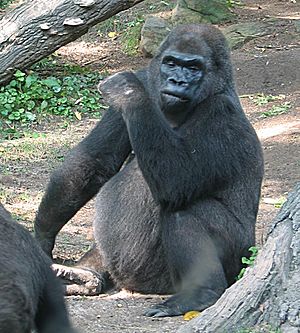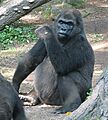Pattycake (gorilla) facts for kids

Photo from 2004
|
|
| Species | Western lowland gorilla |
|---|---|
| Sex | Female |
| Born | September 3, 1972 Central Park Zoo, New York City, United States |
| Died | March 31, 2013 (aged 40) Bronx Zoo, New York, United States |
| Known for | First gorilla born in captivity in New York |
| Parent(s) | Lulu (1964–2011), Kongo (1965–1998) |
| Offspring | 10 |
Pattycake (September 3, 1972 – March 31, 2013) was a famous female western lowland gorilla. She was born at the Central Park Zoo in New York City. Her parents were Lulu and Kongo. Pattycake was special because she was the first baby gorilla successfully born in a zoo in New York.
Soon after her birth, Pattycake had an accident. Her arm got stuck in her cage while her mother was moving her away from her father. The media made a big deal out of it, but experts said it was just an accident. Pattycake's injury was treated at the Bronx Zoo. This led to a big discussion about where she should live. Many people and experts thought she should go back to her mother.
Pattycake became very popular. People loved reading about her recovery and her return to her family. Her story also made people think about how zoo animals lived. Pattycake was like a "child star" in New York City in the 1970s. She brought joy to New Yorkers during a tough time for the city. After living at the Central Park Zoo for ten years, she moved to the Bronx Zoo in 1982. Pattycake became a mother to ten baby gorillas. She lived a long life and was a caring leader in her gorilla group. She passed away in 2013 from heart problems.
Contents
Pattycake's Birth
Pattycake was born on September 3, 1972. Her parents, Lulu and Kongo, were western lowland gorillas at the Central Park Zoo. Lulu and Kongo had arrived at the zoo in 1966. At the time, no one thought Lulu was old enough to have a baby. So, her birth was a big surprise!
Before Pattycake, it was hard for zoos to get gorilla mothers to raise their babies. Sometimes the mothers would not accept their young. Other times, zoo workers had to take the babies away. Pattycake was the first gorilla born and successfully raised in a New York zoo.
When she was born, no one knew if Pattycake was a boy or a girl. It was too risky to get close to her and her parents. Zoo workers thought she was a boy and first named her "Sonny Jim." Later, when they found out she was a girl, the New York Daily News held a contest to name her. A fireman named John O'Connor won with the name "Patty Cake." He named her after his wife and a daughter he hoped to have one day.
Pattycake's birth made the city very excited. Thousands of people came to the Central Park Zoo to see her. A reporter called her a "child star." She gave people a nice break from the city's problems like high crime rates. The zoo director thought she might bring in 500,000 more visitors in her first year.
A Zoo Dispute Over Pattycake
When Pattycake was five months old, she lived with her parents in the Lion House at the Central Park Zoo. On March 20, 1973, an accident happened. Pattycake was reaching out to her father through the cage bars. Her mother, Lulu, suddenly pulled her away. Pattycake's right arm got stuck and broke.
Zoo workers had to use a tranquilizer dart to calm Lulu. This allowed them to get Pattycake and treat her injury. Experts said it was just an accident. But the news media made it sound like a big fight between the parents. A zookeeper named Veronica Nelson said, "The news media would have liked to have it a dramatic bloody mess. It was nothing like that. It was a simple accident."
Pattycake was taken to New York Medical College for surgery. She got a cast for her arm. Because zoo staff worried Lulu might try to remove the cast, Pattycake was moved to the Bronx Zoo. There, she was cared for by veterinarian Emil Dolensek. He later replaced her cast with a sling. During her check-up, staff found Pattycake had parasites and was not eating enough. They also worried Lulu was not a good mother.
This started a disagreement between the two zoos. The Bronx Zoo thought Pattycake would be better cared for there. Time magazine called it the "custody battle of the decade" for animals. They compared Pattycake's fame to that of child star Shirley Temple. A scientist named Ronald Nadler helped decide what was best. He said Pattycake should go back to her mother. He believed a baby gorilla grows up best when raised with its parents.
After three months of healing, Pattycake went back to her mother on June 15, 1973. An artist named Susan Green wrote a book about the whole event called Gentle Gorilla: The Story of Patty Cake.
Better Homes for Zoo Animals
By the 1970s, groups that cared about animals started to worry. They were concerned about how zoo animals were treated. They also worried about the small cages at the Central Park Zoo. Groups like the Humane Society said the cages were like prisons. They asked for changes right away. The New York Zoological Society, which ran the Bronx Zoo, also wanted changes. They wanted Pattycake to move to a bigger zoo.
A plan to fix up the Central Park Zoo was approved in 1981. This plan included moving the gorillas to larger spaces in other zoos. The New York Times reported that animal lovers had been upset for a long time about animals being kept in small cages.
Life at the Bronx Zoo
Pattycake moved to the Bronx Zoo for good on December 20, 1982. This was just before the Central Park Zoo closed for renovations in 1983. For a few years, she lived in a cage with a chimpanzee named Pansy.
In June 1999, Pattycake moved into the Bronx Zoo's new Congo Gorilla Forest exhibit. This exhibit cost $43 million. It has a special viewing area where visitors can see the gorillas through a glass window. Two groups of gorillas lived in the 6.5-acre exhibit. Pattycake's group had about a dozen gorillas. The zoo's curator, James Doherty, said Pattycake was "independent." She didn't have many close friends in the Congo Gorilla Forest. He thought this might be because she didn't live with her parents for very long. She also lived with a chimpanzee for some years.
Pattycake's Family and Offspring
Pattycake became a mother for the first time on January 20, 1985. Her first baby was a male gorilla named Tumai. His father was Bendera. Pattycake and Bendera had another baby in March 1986, but it sadly died soon after birth.
With another male gorilla named Barney, Pattycake had three more babies. These were Paki (a female) born in May 1989, Patrick born in April 1990, and Husani born in December 1991. Paki later had a baby named Pendeka in 1998. Pendeka was Pattycake's only grandchild.
In 1991, a silverback gorilla named Timmy came to the Bronx Zoo. He was brought there to help breed lowland gorillas. This would add new genes to the gorillas living in zoos. On July 11, 1993, Pattycake and Timmy had a male baby named Okpara. They also had twin male gorillas, Ngoma and Tambo, on August 8, 1994. This was only the sixth time western lowland gorillas had given birth to twins in a zoo. The twins were raised by other mother gorillas. In 2001, Ngoma and Tambo moved to a zoo in Nebraska.
On February 4, 2001, Pattycake and a gorilla named Zuri had a female baby named Dossi. Pattycake's last baby, a male, was born on April 15, 2002. He was her tenth baby, but he died four days later.
Later Life and Legacy
Pattycake's father, Kongo, passed away in 1998. In 2002, the Pattycake Fund was started. This fund aimed to raise money to help stop the illegal hunting of African gorillas. This fundraising happened around Pattycake's 30th birthday. The Bronx Zoo celebrated her birthday for two days. They even made her a special cake from kale, gelatin, yogurt, and berries!
In May 2004, Timmy and two female gorillas, Tunuka and Paki, moved from the Bronx Zoo to the Louisville Zoo.
Pattycake even tried painting! She took part in an animal enrichment program at the Bronx Zoo. A sample of her artwork was shown in a report in 2010. Pattycake's mother, Lulu, died in early 2011.
As Pattycake got older, she had health problems like heart disease and arthritis. She passed away in her sleep at the age of 40. At the time, she was one of 338 gorillas living in zoos in North America. Pattycake lived longer than the average life span for female zoo gorillas, which is about 37 years.
Pattycake in Books and Songs
Pattycake was so famous that she was featured in songs and books! The Rev. Frederick Douglass Kirkpatrick (Brother Kirk) and Pete Seeger sang "Patty Cake Gorilla." This song was on the album Pete Seeger and Brother Kirk Visit Sesame Street (1974).
Elizabeth Moody wrote a picture book called Patty Cake (1974). It included photos by New York Times photographer Neal Boenzi. Pearl Wolf also wrote a children's picture book called Gorilla Baby: The Story of Patty Cake (1974). Artist Susan Green shared her own drawings and observations about the zoo dispute in her book Gentle Gorilla: The Story of Patty Cake (1978).
Images for kids


